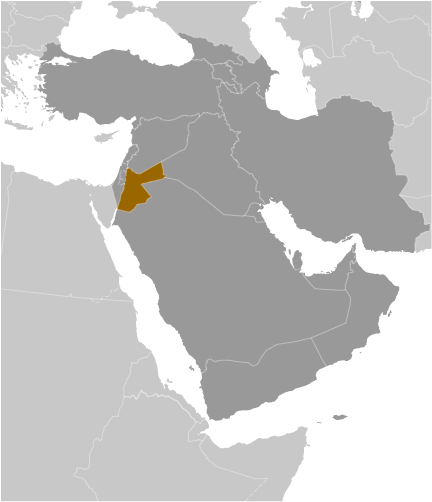
|
|
Advertisements:
People And SocietyNationality
Noun Jordanian(s)
Adjective Jordanian Ethnic groups
Arab 98%, Circassian 1%, Armenian 1% Languages
Arabic (official), English (widely understood among upper and middle classes) Religions
Sunni Muslim 92% (official), Christian 6% (majority Greek Orthodox, but some Greek and Roman Catholics, Syrian Orthodox, Coptic Orthodox, Armenian Orthodox, and Protestant denominations), other 2% (several small Shia Muslim and Druze populations) (2001 est.) Population World Ranking: 104
6,508,887 (July 2012 est.)
Age structure
0-14 years
35.3% (male 1,180,595/female 1,114,533) 15-64 years 59.9% (male 1,977,075/female 1,921,504) 65 years and over 4.8% (male 153,918/female 160,646) (2011 est.) Median age
Total 22.4 years
Male 22 years Female 22.7 years (2012 est.) Population growth rate World Ranking: 226
-0.965% (2012 est.)
Birth rate World Ranking: 49
26.52 births/1,000 population (2012 est.) Death rate World Ranking: 219
2.74 deaths/1,000 population (July 2012 est.) Net migration rate World Ranking: 219
-33.42 migrant(s)/1,000 population (2012 est.) Urbanization
Urban population 79% of total population (2010)
Rate of urbanization 1.6% annual rate of change (2010-15 est.) Major cities - population
AMMAN (capital) 1.088 million (2009) Sex ratio
At birth 1.06 male(s)/female
Under 15 years 1.06 male(s)/female 15-64 years 1.03 male(s)/female 65 years and over 0.95 male(s)/female Total population 1.03 male(s)/female (2011 est.) Maternal mortality rate World Ranking: 97
63 deaths/100,000 live births (2010) Infant mortality rate World Ranking: 109
Total 15.83 deaths/1,000 live births
Male 16.42 deaths/1,000 live births Female 15.2 deaths/1,000 live births (2012 est.) Life expectancy at birth World Ranking: 29
Total population 80.18 years
Male 78.82 years Female 81.61 years (2012 est.) Total fertility rate World Ranking: 51
3.36 children born/woman (2012 est.) Health expenditures World Ranking: 150
4.5% of GDP (2009)
Physicians density
2.45 physicians/1,000 population (2009) Hospital bed density
1.8 beds/1,000 population (2009) Hiv/aids - adult prevalence rate World Ranking: 132
Less than 0.1% (2001 est.)
Hiv/aids - people living with hiv/aids World Ranking: 149
600 (2007 est.)
Hiv/aids - deaths World Ranking: 88
Fewer than 500 (2003 est.)
Obesity - adult prevalence rate World Ranking: 23
19.5% (2004)
Education expenditures
NA
Literacy
Definition
Age 15 and over can read and write Total population 92.6%Male 95.8% Female 89.2% (2010 est.) School life expectancy (primary to tertiary education)
Total 13 years
Male 13 years Female 13 years (2008) Unemployment, youth ages 15-24 World Ranking: 21
Total 27%
Male 22.6% Female 45.9% (2009)
Comments
Add a new comment: |
Advertisement
Members area
Jordan (Amman):
 
GPS points from Jordan (Amman)
|
||||||||

 Following World War I and the dissolution of the Ottoman Empire, the UK received a mandate to govern much of the Middle East. Britain separated out a semi-autonomous region of Transjordan from Palestine in the early 1920s, and the area gained its independence in 1946; it adopted the name of Jordan in 1950. The country's long-time ruler was King HUSSEIN (1953-99). A pragmatic leader, he successfully navigated competing pressures from the major powers (US, USSR, and UK), various Arab states, Israel, and a large internal Palestinian population. Jordan lost the West Bank to Israel in the 1967 war and defeated Palestinian rebels who attempted to overthrow the monarchy in 1970. King HUSSEIN in 1988 permanently relinquished Jordanian claims to the West Bank. In 1989, he reinstituted parliamentary elections and initiated a gradual political liberalization; political parties were legalized in 1992. In 1994, he signed a peace treaty with Israel. King ABDALLAH II, King HUSSEIN's eldest son, assumed the throne following his father's death in February 1999. Since then, he has consolidated his power and implemented some economic and political reforms. Jordan acceded to the World Trade Organization in 2000, and began to participate in the European Free Trade Association in 2001. In 2003, Jordan staunchly supported the Coalition ouster of SADDAM in Iraq and, following the outbreak of insurgent violence in Iraq, absorbed thousands of displaced Iraqis. Municipal elections were held in July 2007 under a system in which 20% of seats in all municipal councils were reserved by quota for women. Parliamentary elections were last held in November 2010 and saw independent pro-government candidates win the vast majority of seats.
Following World War I and the dissolution of the Ottoman Empire, the UK received a mandate to govern much of the Middle East. Britain separated out a semi-autonomous region of Transjordan from Palestine in the early 1920s, and the area gained its independence in 1946; it adopted the name of Jordan in 1950. The country's long-time ruler was King HUSSEIN (1953-99). A pragmatic leader, he successfully navigated competing pressures from the major powers (US, USSR, and UK), various Arab states, Israel, and a large internal Palestinian population. Jordan lost the West Bank to Israel in the 1967 war and defeated Palestinian rebels who attempted to overthrow the monarchy in 1970. King HUSSEIN in 1988 permanently relinquished Jordanian claims to the West Bank. In 1989, he reinstituted parliamentary elections and initiated a gradual political liberalization; political parties were legalized in 1992. In 1994, he signed a peace treaty with Israel. King ABDALLAH II, King HUSSEIN's eldest son, assumed the throne following his father's death in February 1999. Since then, he has consolidated his power and implemented some economic and political reforms. Jordan acceded to the World Trade Organization in 2000, and began to participate in the European Free Trade Association in 2001. In 2003, Jordan staunchly supported the Coalition ouster of SADDAM in Iraq and, following the outbreak of insurgent violence in Iraq, absorbed thousands of displaced Iraqis. Municipal elections were held in July 2007 under a system in which 20% of seats in all municipal councils were reserved by quota for women. Parliamentary elections were last held in November 2010 and saw independent pro-government candidates win the vast majority of seats.